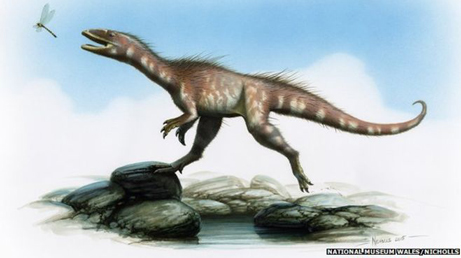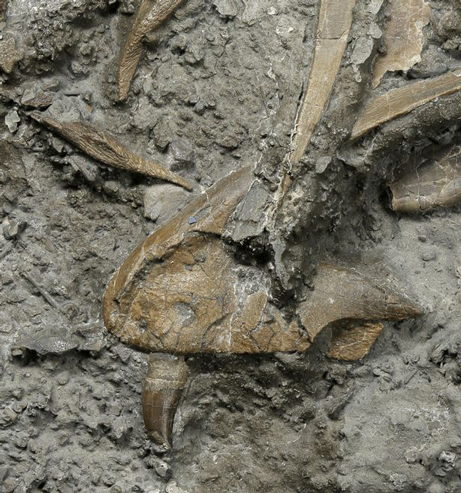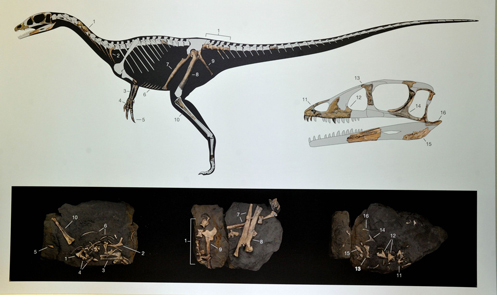Early Jurassic Dinosaur Goes on Display
The story broke this week of the discovery of a new species of meat-eating dinosaur after fossils found at Lavernock beach (near Penarth, South Wales), went on display at the National Museum of Wales. Many of the news reports that carried this story heralded this important discovery and claimed that this new meat-eating dinosaur was a Welsh cousin of the famous Tyrannosaurus rex. Whilst it is true, this lithe and agile theropod was indeed distantly related to T. rex it is important to stress the term “distantly” in this context.
The domestic cat is much more closely related to a tiger than this Welsh dinosaur was to the North American “King of the Tyrant Lizards”, at least a domestic cat and a tiger belong to the same taxonomic family (Felidae).
A New Early Jurassic Dinosaur has been Discovered
Picture credit: National Museum of Wales/Bob Nicholls
The Theropoda
The theropods (Theropoda) are a suborder of dinosaurs, they are lizard-hipped and perhaps the most diverse and most specious of all the Dinosauria. This new fossil find is important for a number of reasons. Firstly, the Lavernock shales represent strata formation in a shallow, marine environment. These rocks were laid down at the very beginning of the Jurassic geological period (Hettangian faunal stage), this discovery is one of just a handful of dinosaur fossils known from this location.
Most of the dinosaur material from the Lavernock Point area that had been found in the past consisted of highly eroded, isolated and very fragmentary bones. The rocks do preserve fossils of vertebrates, fish scales and teeth are the most common finds these too are usually quite worn.
Early Jurassic Dinosaur
It seems some 200 million years ago, the carcase of a not fully grown, meat-eating dinosaur was washed out to sea, when the corpse sank, it was covered in fine silt and the fossilisation process began. The five blocks in which the largely disarticulated fossil was found, (bone material representing about 5% of the total skeleton), were washed out of the cliffs during storms in the spring of 2014. Brothers Nick and Rob Hanigan were responsible for making the fossil find. One of the brothers came across the exposed blocks whilst out fossil hunting and alerted his brother to help explore the immediate location after the rock fall.
Nick and Rob were able to locate a number of bones including fragments of the skull and some very fine examples of the dinosaur’s teeth. They are to be congratulated for their discovery, had the fossils remained exposed on the beach for just a few weeks they may have been subjected to erosion or even washed out to see with the next high tide and therefore potentially lost forever.
For models and figures of Jurassic dinosaurs and other prehistoric creatures: Mojo Fun Prehistoric and Extinct Models.
A Close up of the Upper Jaw Bone and Tooth Surrounded by Other Skull Material
Picture credit: National Museum of Wales
Welsh Dinosaur Discovery
Fragmentary fossils that have been assigned to the Dinosauria have been found in this part of the British Isles before, we have had the opportunity to look at pictures of a number of specimens from south, central England.
These specimens consist of, for the most part, isolated bones, here is an Early Jurassic Theropod dinosaur that is represented by a lot more fossil material. The specimen has been studied by scientists from the National Museum of Wales, along with experts from Manchester and Portsmouth Universities. We are expecting a formal scientific paper to be published in the autumn and we think that the distinguished University of Portsmouth palaeontologist Dr David Martill we be one of the authors.
Dr John Nudds, (Manchester University), who has examined the specimen stated:
“It is very rare to find this type of dinosaur at all and never before in Wales. In fact it is only the second dinosaur ever found in Wales.”*
The Blocks of Material and a Reconstruction on Display at the National Museum of Wales
Picture credit: National Museum of Wales
A Welsh Dinosaur
We are aware of a number of ichnogenera described from trace fossils found near Bendrick Rock, down the coast from the Lavernock site. Theropod footprints have been found in Wales, but body fossils are extremely rare. The first dinosaur described from Welsh deposits is Pantydraco caducus, which is known from a partial skull and post cranial material, it belongs to the Sauropodomorpha group and its fossils were collected from a quarry in Bonvilston, about six miles north-west of the Lavernock fossil discovery. Could Pantydraco have been attacked by this, as yet, unnamed theropod? The answer is no, the strata in which the fossils of Pantydraco were found are several million years older than the Lavernock sediments.
The Lavernock Specimen
In addition, the Lavernock specimen represents an individual that would have been around half a metre high at the hips and measuring around two to three metres in length. It is very likely that this little meat-eating dinosaur fed on insects, small reptiles and mammals, although when fully grown, perhaps over five metres in length, other Early Jurassic dinosaurs including sauropodomorphs were probably on the menu.
* This may not be the second dinosaur fossil discovered in Wales, isolated bone fragments have been found in South Wales from near Bridgend and from the Lavernock area. Unfortunately, these fossils are very difficult to assign with any certainty to a specific clade of the Dinosauria. They may not represent dinosaurs at all but other related archosaurs.
We shall have to wait for the scientific paper, this will provide a lot more information and also help to assign this particular specimen to a family. We suspect that the fossils represent a member of the Coelophysidae, it will most certainly be a new species. So very few fossils of Late Triassic/Early Jurassic theropod dinosaurs have been found, a time when the Theropoda were diversifying and evolving into a number of new forms. This little dinosaur may represent the earliest known dinosaur from the Jurassic.
Illustrating the Dinosaur
There are a couple of things to note about the illustration produced by the highly talented palaeo-artist Bob Nicholls, first of all the animal is not painted a dull grey or brown. This dinosaur has a reddish hue with distinctive white markings, a sign of the times as more colourful depictions of the Dinosauria are now becoming the norm. In addition, this theropod dinosaur has quills and tufts of simple feathers. This is a nod to the now widely accepted theory that most theropod dinosaurs were indeed feathered.
More Information About British Dinosaurs
Picture credit: Siri Scientific Press
For further information on dinosaurs from the British Isles we recommend the excellent “Dinosaurs of the British Isles” by Dean R. Lomax and Nobumichi Tamura
Copies can be purchased here: Siri Scientific Press.










Mike,
Thank you for your kind comments. The paper is actually complete and we hope that it will be published in the near future. The mudstone that the bones are in does not last very long in water and the bones fall apart very quickly. When the skull block was picked up, quite a bit of bone eg the lacrimal and part of the maxillae had already been washed out but the imprints were still left in the rock. We took a silicon peel and made positive and negative casts of the surface and we also x-rayed and CT scanned the block before we prepped it. As a result Rob and I built up a lot of information to support any future description and as such we can reconstruct quite a bit of the skull and missing part of the leg bones. When the paper has been published, our intention is to put out another with a detailed description of how the dinosaur was found, conserved and prepared by us. I hope this is of interest. Best regards
Nick Hanigan
You and your brother did a fantastic job, we were informed about the find a little while ago. It really is a wonderful discovery and we congratulate everyone involved. We are looking forward to the published paper.